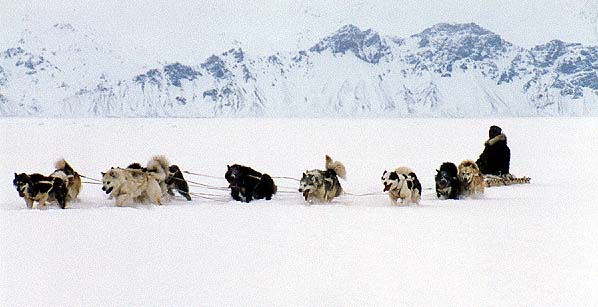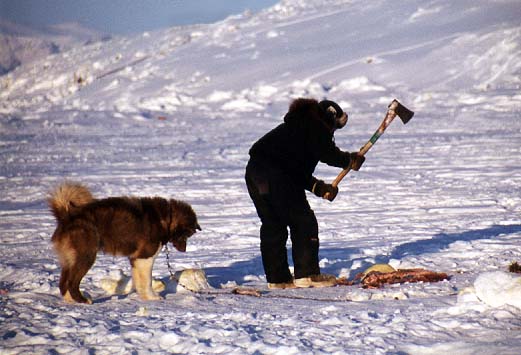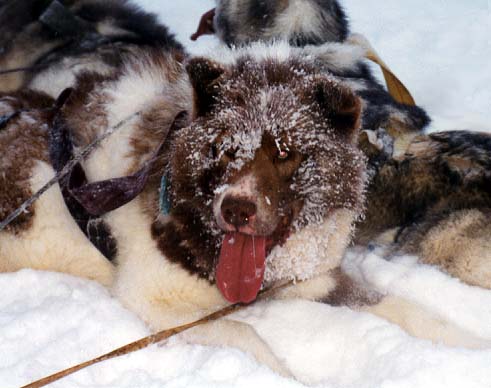Table of Contents
*
Nunavut Quest 2000:
More Than a Race
*
Nunavut Quest 2000:
Drivers' Meeting
*
Nunavut Quest 2000:
On the Trail
*
Nunavut Quest 2000:
Race Results
*
Poem: Dogs of the Sledge Trail
*
Inuit Demand Inquiry of Historical Dog Extermination Policy
*
Memories
*
Nunavut's Official Symbols
*
Niels Pedersen, D.V.M:
The Veterinary Service in Greenland
*
ISDI Foundation:
Acknowledgements
*
Sled Dog Problems in Iqaluit
*
Baking: Dog Cookie Recipe
*
Crafts: Save That Hair
*
Behavioral Notebook:
Social Order
*
Book Review:
Polar Dream
*
In My Humble Opinion:
Sharing the Trail
*
Update:
Ihe ISDVMA Meeting
Navigating This
Site
Index of articles by subject
Index
of back issues by volume number
Search The
Fan Hitch
Articles
to download and print
Ordering
Ken MacRury's Thesis
Our
comprehensive list of resources
Talk
to The Fan
Hitch
The Fan Hitch
home page
ISDI
home page
Editor: Sue Hamilton
Webmaster: Mark Hamilton
Contents of The Fan Hitch Website and its publications are protected by international copyright laws. No photo, drawing or text may be reproduced in any form without written consent. Webmasters please note: written consent is necessary before linking this site to yours! Please forward requests to Sue Hamilton, 55 Town Line Rd., Harwinton, Connecticut 06791, USA or mail@thefanhitch.org

Camp on the sea ice. Note the dog food in the foreground,
flippers to the sky. Hamilton photo
Nunavut Quest 2000:
On the Trail to Arctic Bay
[What follows is an interpretation of writer, photographer and official race timer Lee Narroway's experiences on the trail with the Nunavut Quest 2000, based on her upcoming article in Above & Beyond Magazine.]
The clear, albeit somewhat warm, weather at the start of the race was no indication of what lay ahead. In fact it was within an hour of the sunny start and almost carnival like atmosphere back in the north Baffin hamlet of Pond Inlet, that good weather was but a memory. Mushers had only begun to chip away at the 450 kilometre trek to the finish line when the scores of people, dogs and snowmachines were in the throat of a raging blizzard. These were brutal conditions. It was tough enough being the driver and sole occupant of a dog-powered qamutik. Lee was riding a qamutik pulled by a snowmachine. Traveling on a sea buckled with pressure ridges relentlessly slammed her spine and body. In whiteout conditions it was nearly impossible to use the movement of the snowmachine ahead to provide the warning to prepare herself for the next concussion. Added to this was a fierce and dispassionate cold wind and hard driven snow. She developed an approach avoidance conflict over the need to remove four layers of caribou skins and machine made clothing to answer the call of nature knowing she needed to preserve every bit of body heat for what may lie ahead. Mother Nature never gives a damn whether you live or die. Despite all this and the total uncertainty of what would have to be endured and for how long, there was the other side... the breathtaking scenery (occasionally visible), the privilege of a southerner to be accepted as part of this "family", to share in the totality of the experience, to get more than just an outsider's glimpse into a 4,000 year old tradition and perhaps a vanishing way of life.
Lee Narroway described the Nunavut Quest, "This race is fraught with the danger of polar bears, daunting snow and ice conditions, severe temperatures and unpredictable weather. Unlike any other sled dog race, it is run between totally isolated communities. There are no sophisticated support systems, no shelters situated on the land for man or dogs, no hovering helicopters, no set trails or directional markers and no veterinary or medical presence. The only contact with the outside world is a small orange radio. Support crews travel together and set up daily camps but mushers must be totally self-sufficient and prepared for any emergency. They carry food, a rifle, sleeping skins, snow saw (for igloo construction), and an emergency radio."

Hamilton
photo
She goes on to say, "The Canadian Inuit Dog is a breed unto itself. It has evolved into a magnificent endurance animal, not a fine-tuned racing machine like southern husky breeds, but an incredibly, tenacious dog with the ability to work hard for extended periods of time, despite frigid temperatures, appalling weather conditions and limited food."
Day one for Lee did not end upon her arrival at the first camp site. It was seven hours later before the first team emerged from the whiteout to cross the finish line, marked only by a red gas can opposite a snowmachine. For six more hours she waited in the storm, stopwatch in hand in caribou mitt, to clock in the remaining twelve teams. And this is how seven of the 8 days of what was originally planned as a 5 day race ended. Minus 50 degree temperatures, relentless winds, a blizzard lasting 72 hours, and deep powder snow set the terms of the race beyond the 27 rules put to paper by humans.
But the unusual depth of the snow was no match for the depth of the human spirit driven to press on towards Arctic Bay. And so the necessities of the endeavor were routinely carried out despite weather severe enough to freeze humans, dogs and machines in their tracks. Mushers tended to their dogs' needs, with the daily ritual of using an ax to portion frozen seal carcasses for food. One driver made sure the fur on his team of twelve’s feet was clipped short with a scissors in order to minimize the collection of balls of snow between the pads. Another driver actually watered his dogs every day of the race. This unusual move had to have been a daunting task under the circumstances.

Chopping up a seal carcass for the
dogs
Hamilton
photo
After bravely sampling the green fuzzy stuff freshly "unzipped" from the stomach of a caribou, Lee might have been ready for anything. But warming in a pot on the Coleman stove was something thick and dark and onerous in aroma. Dinner? Oh no! When done, instead of ladling the brew onto plates, the "chef" applied thin coats of this slurry of earth to his qamutik's runners, all 32 feet. Alternating this with pieces of water soaked snow followed by smoothing the surface with a mitted hand, the process added nearly 4 inches to the height of the runners. Scraping and final layers of water, blood or urine made for a hard surface. This meticulous process was to be repeated daily to reduce drag and make the dogs' job somewhat easier. But easier was a relative term on this trip for in some places the trail went over land, up hills covered in thigh high snow.
What appeared to be the improvisational treatment of the sled runners was actually a time honored part of travel on the land. This stands in contrast to the time spent in camp when, waiting out a storm seen in the distance on the trail to the next check point, a game of soccer was conducted improvising with a ball made up of socks tightly bound up with string!
The morning of the eighth day on the trail was blessed by the absence of wind. There was no doubt that this was to be the final day of the race, and a short one at that. Camp had purposely been set up just 25 km from the final finish line in Arctic Bay. A mass start, similar to the one for the sprint tune-up race nine long days ago in Pond Inlet, more or less ensured that even the last teams to cross the final finish line were assured of an enthusiastic greeting by the 600 residents of Arctic Bay who eagerly awaited their arrival.

After a
run
Hamilton
photo
The Inuit Sled Dog International is indebted to Lee Narroway for sharing some of her thoughts with Fan Hitch readers. Look for her Nunavut Quest 2000 story and beautiful photos in the September/October issue of Above & Beyond, Magazine of the New North. For subscription information call toll free 1-877-227-2842; or call 1-613-599-4190; e-mail at <info@above-n-beyond.com>. Visit the Above & Beyond home page at <www.above-n-beyond.com>.